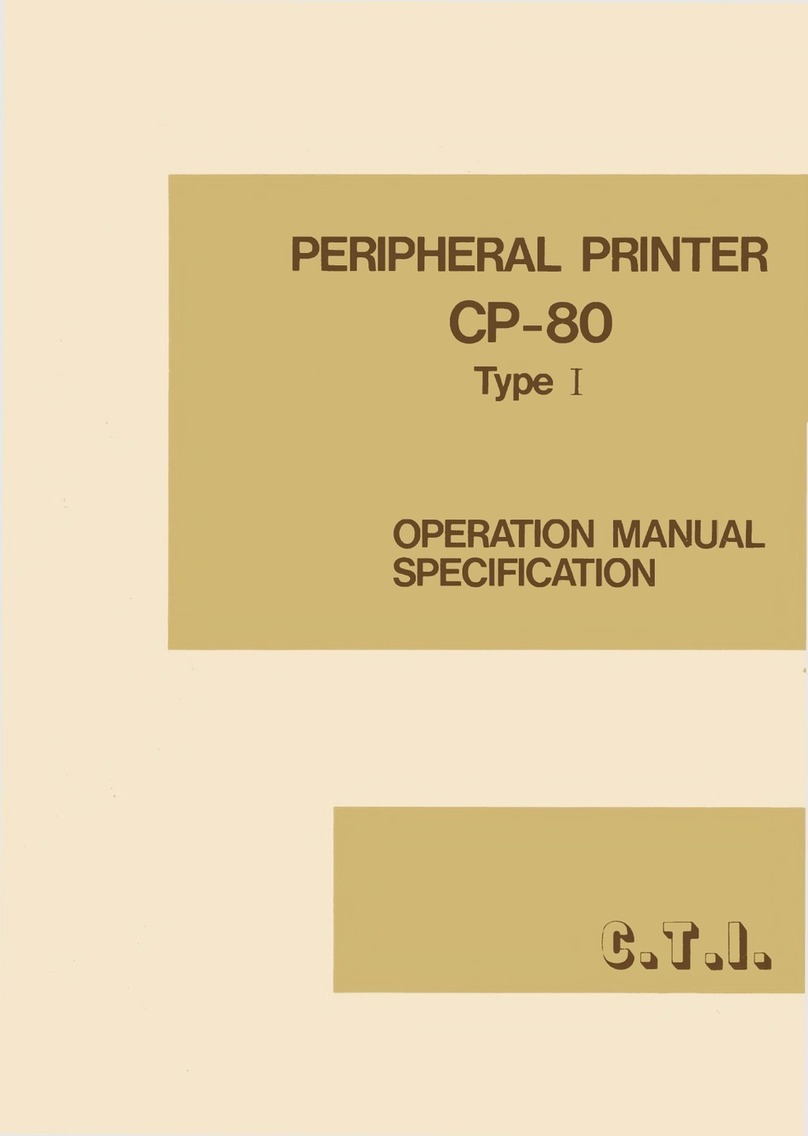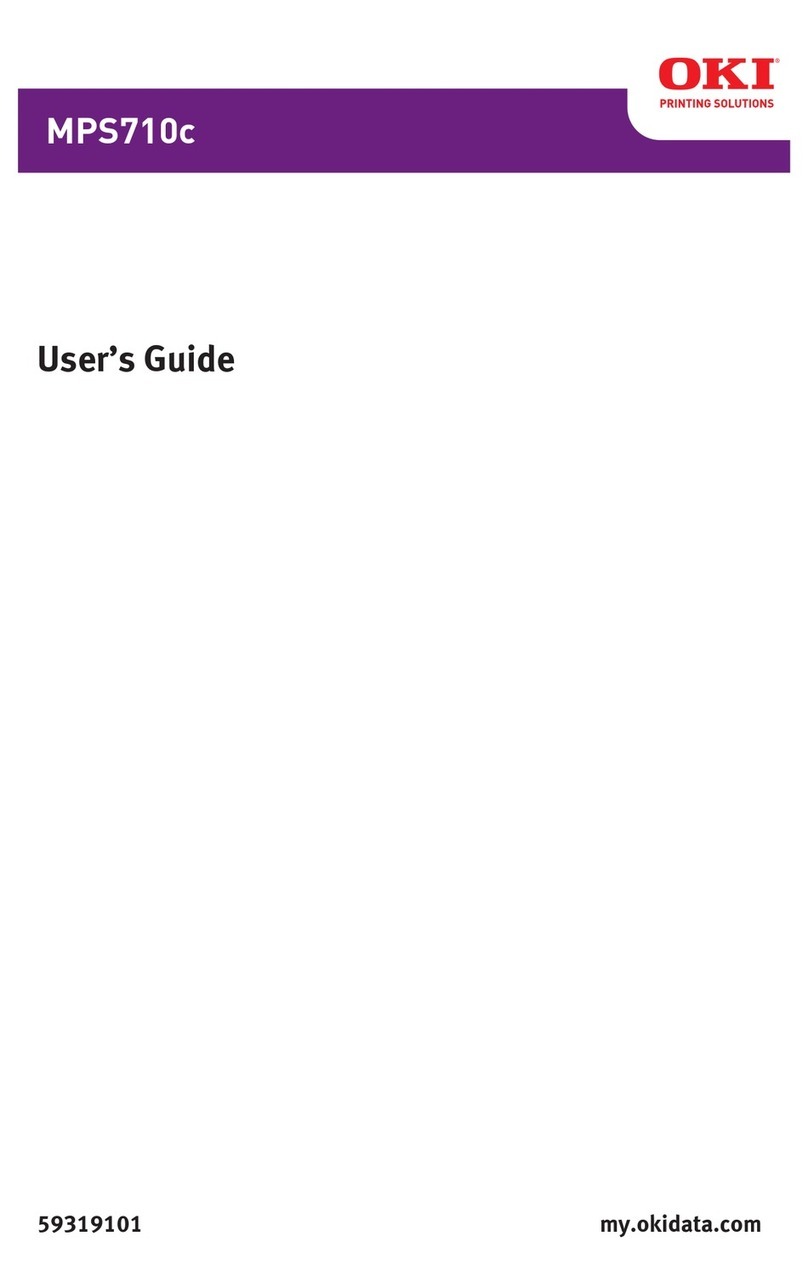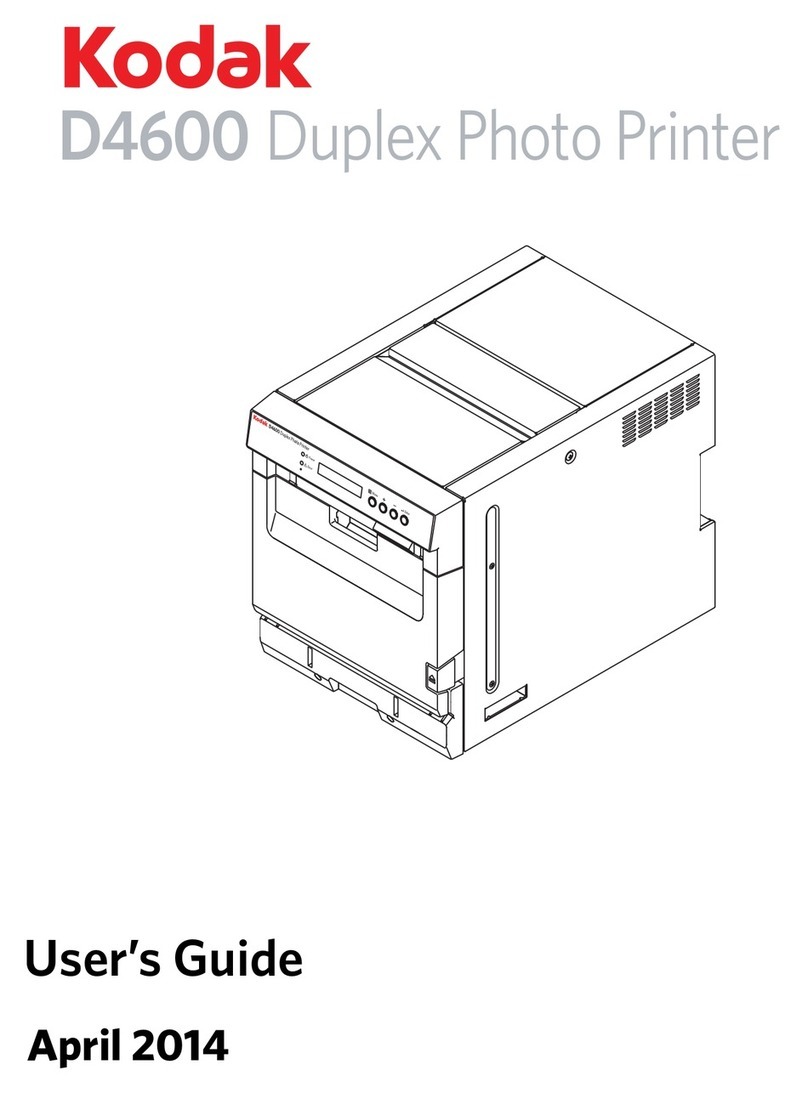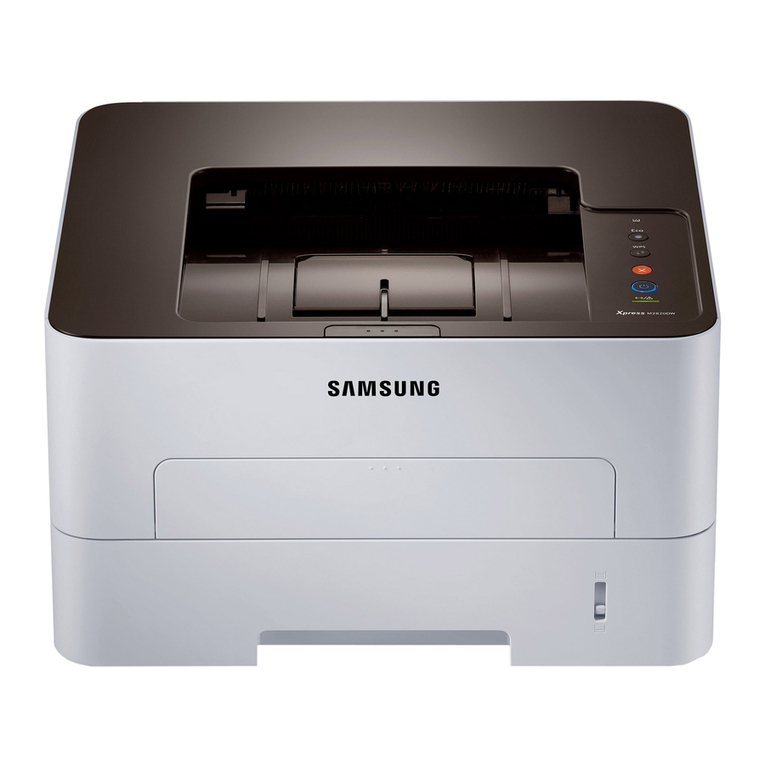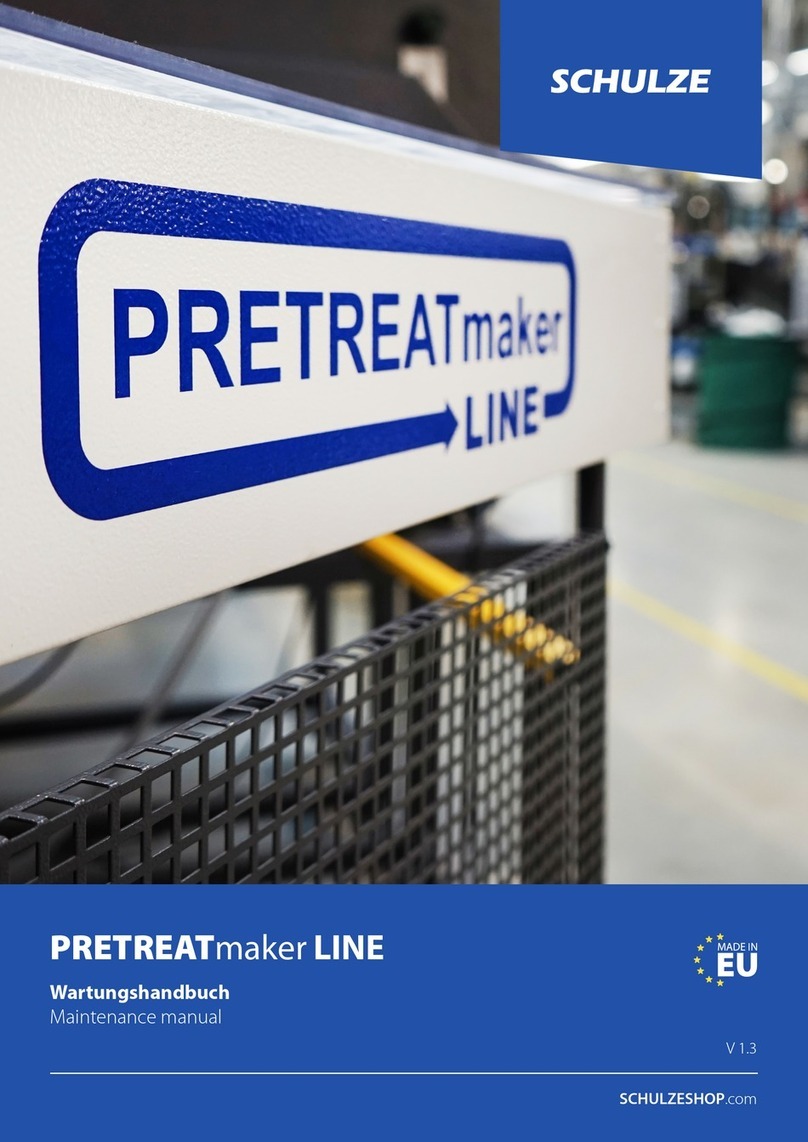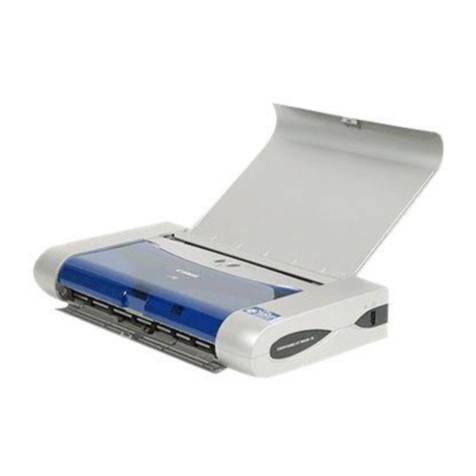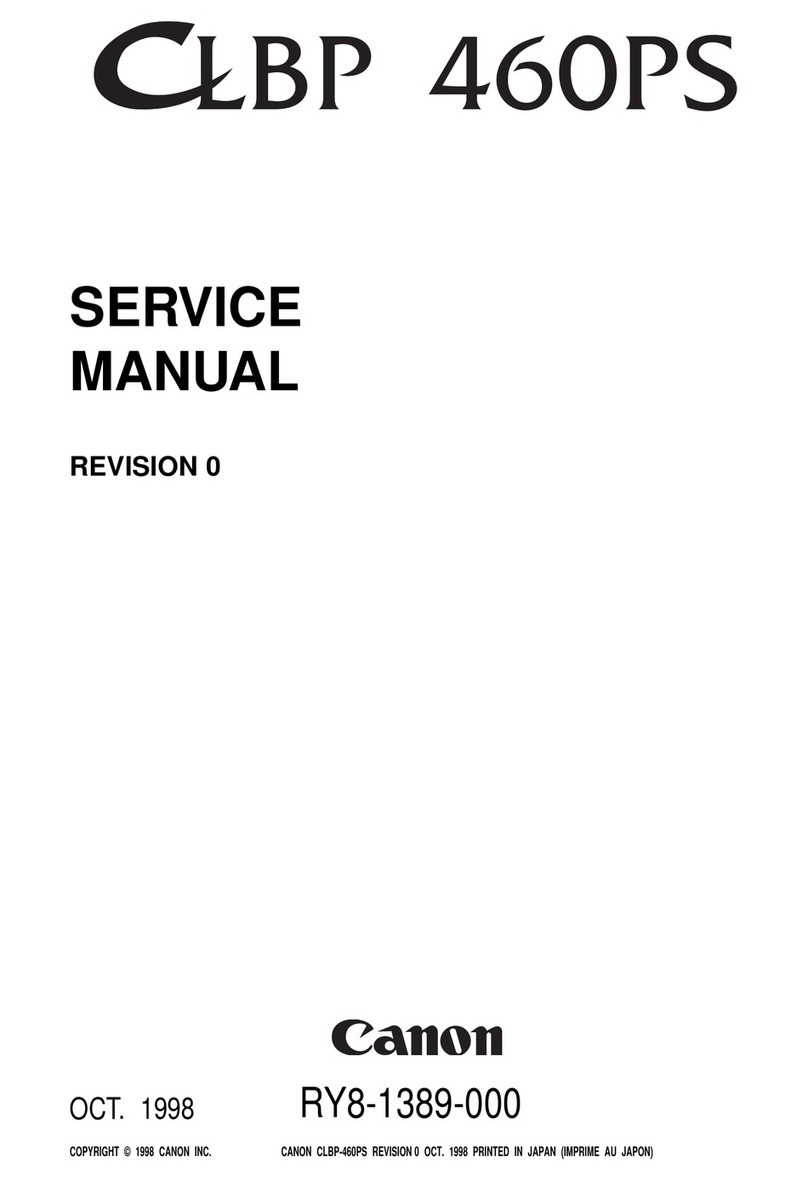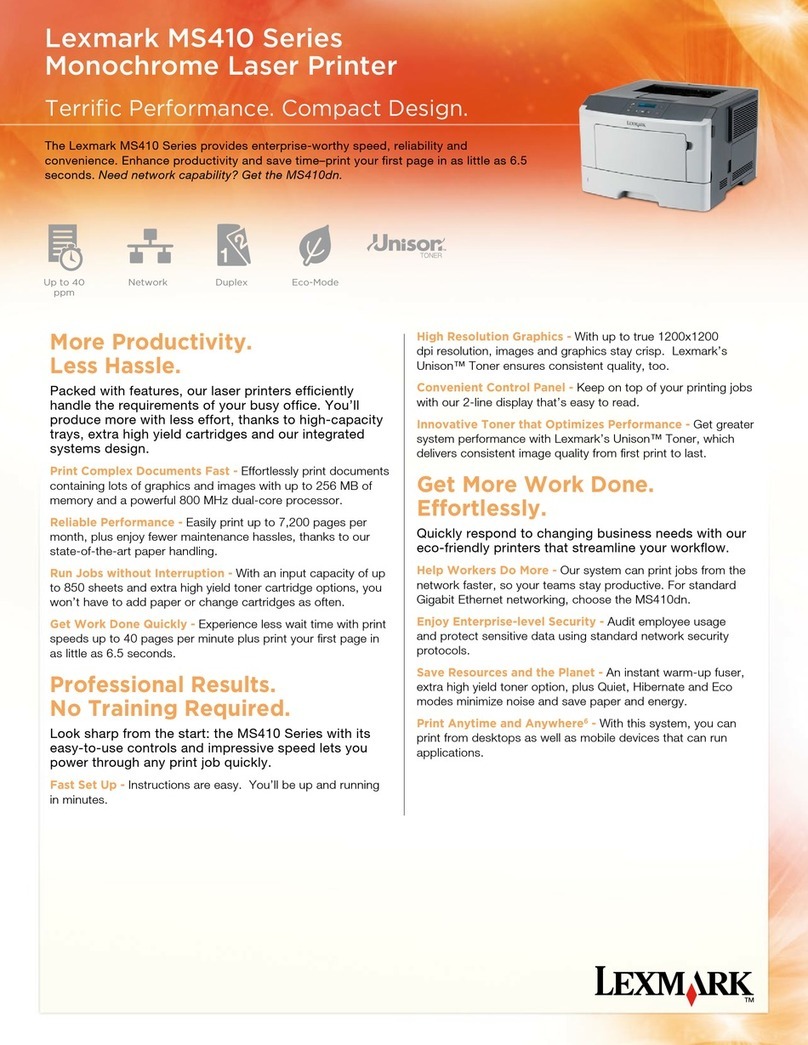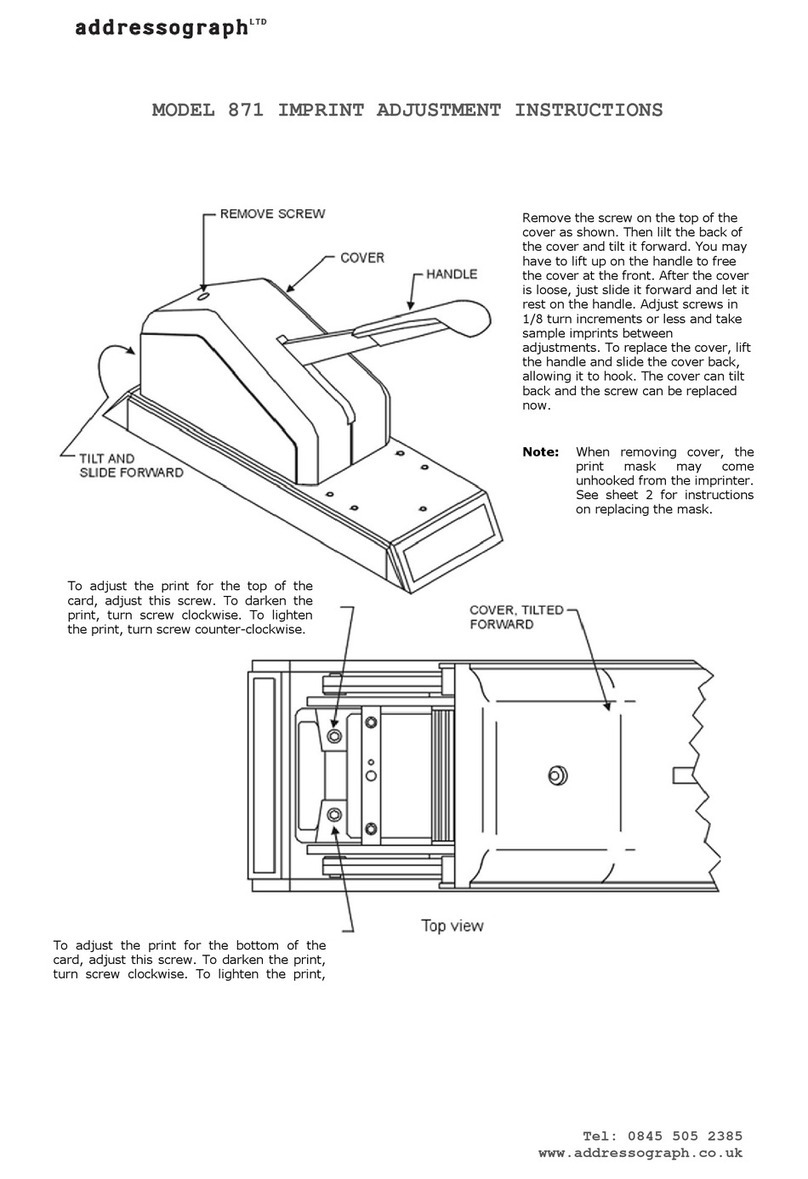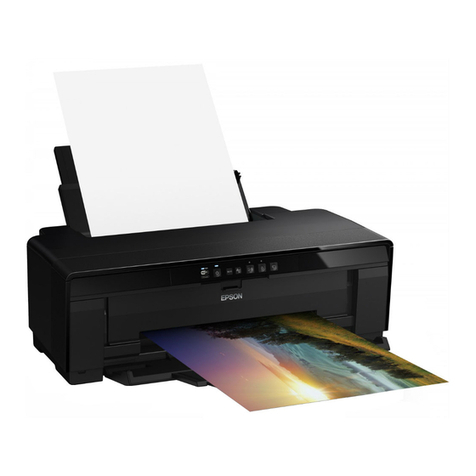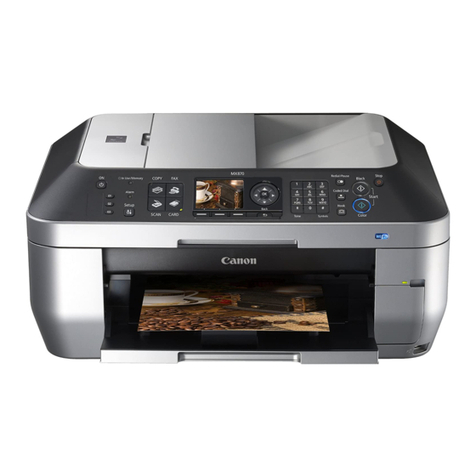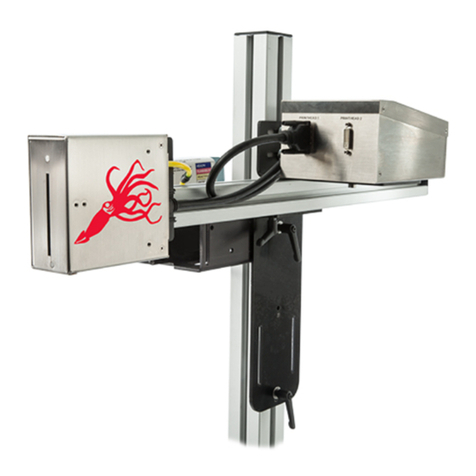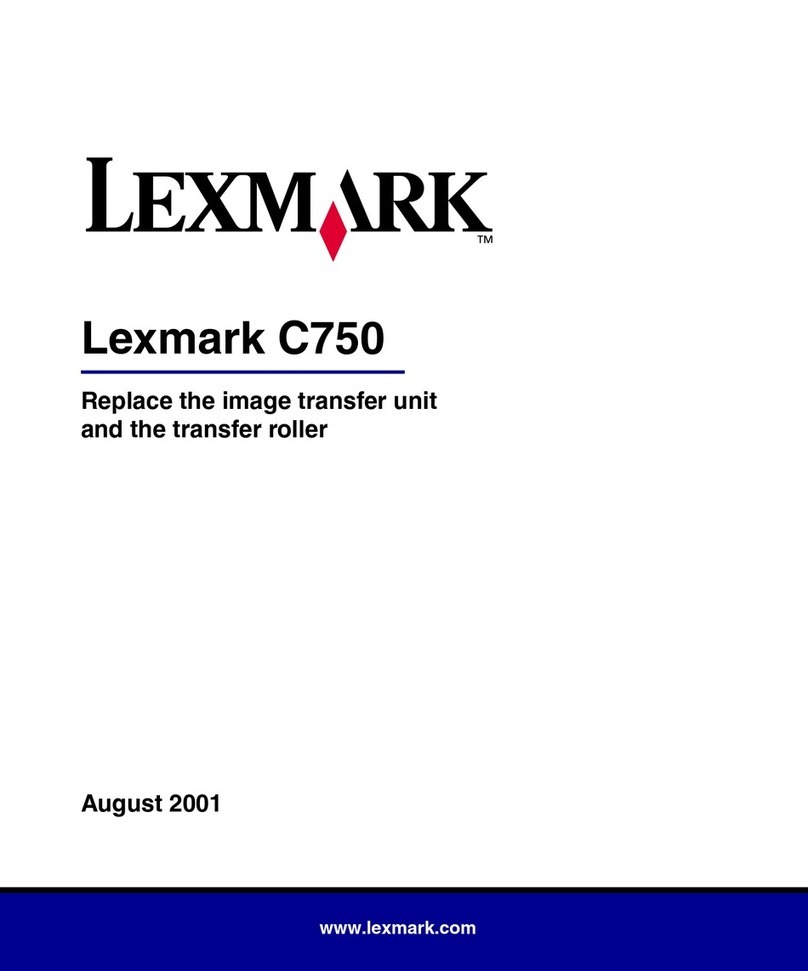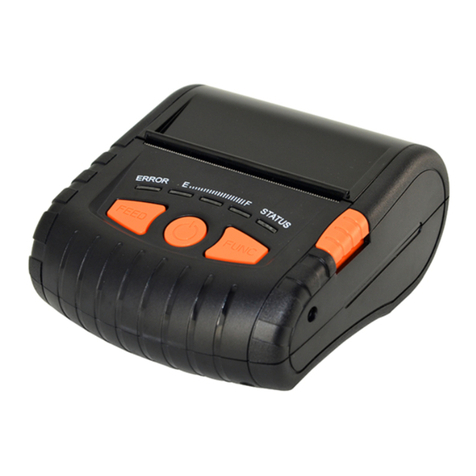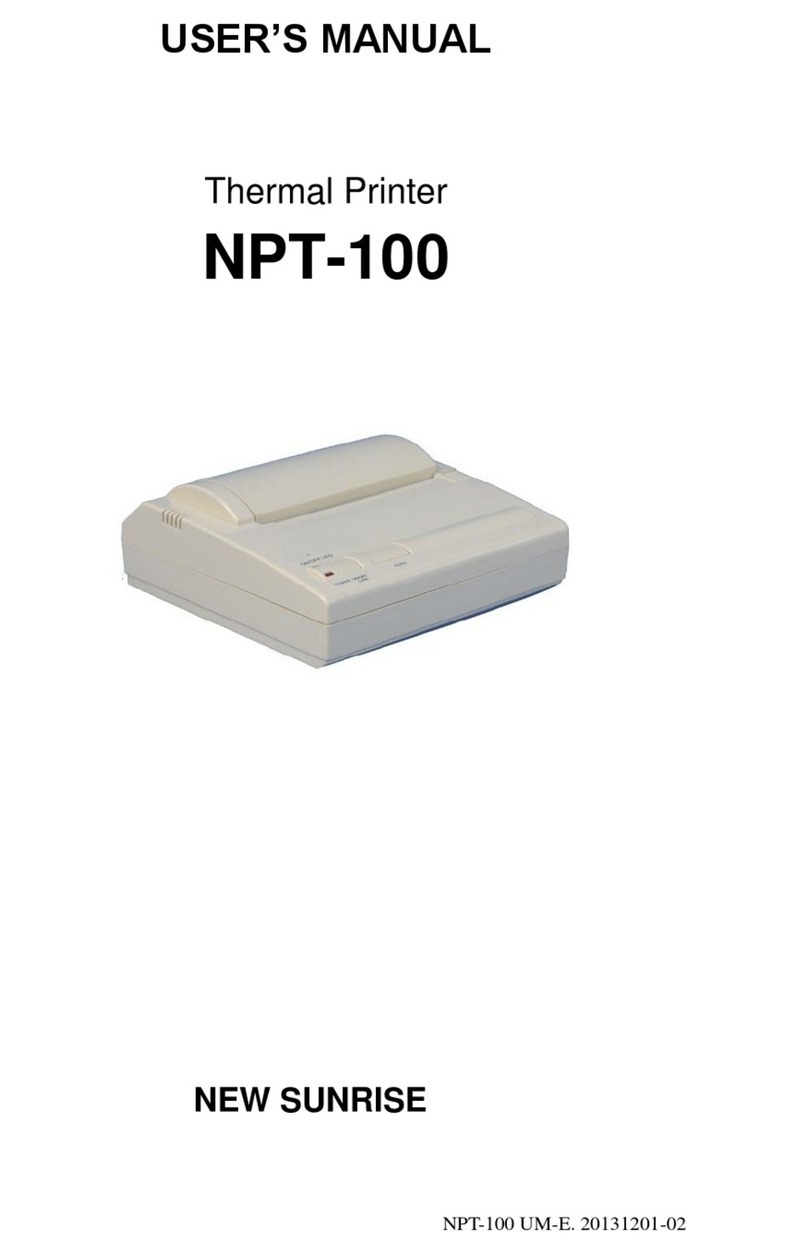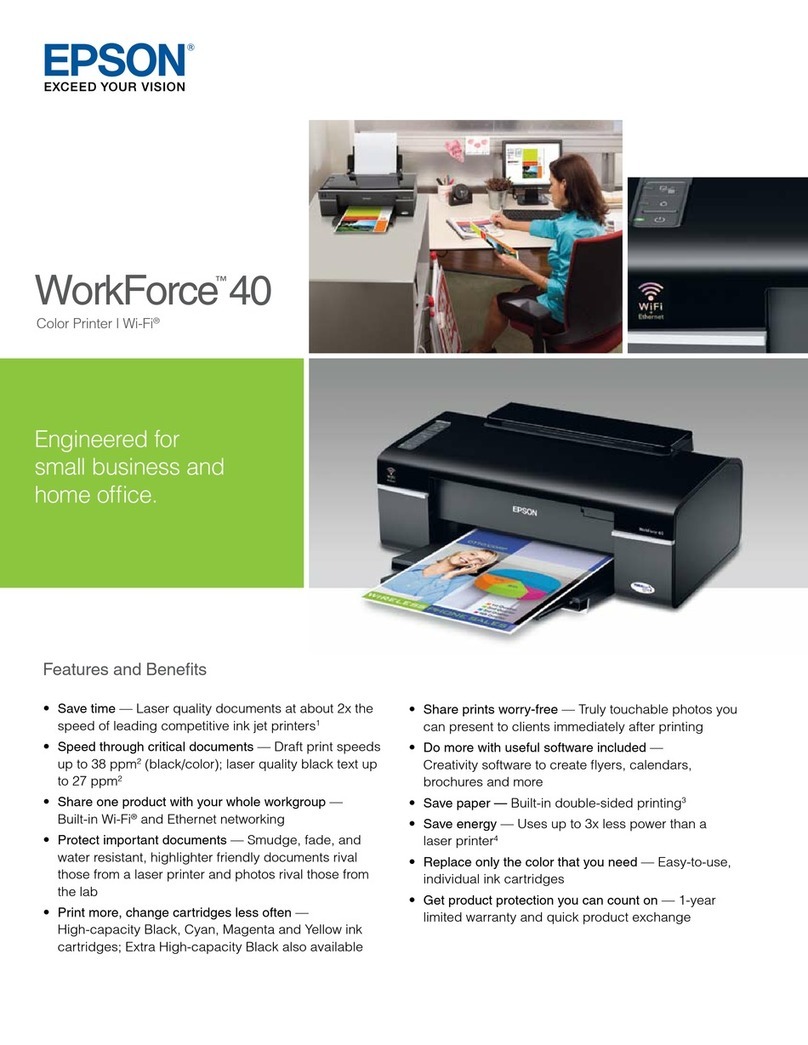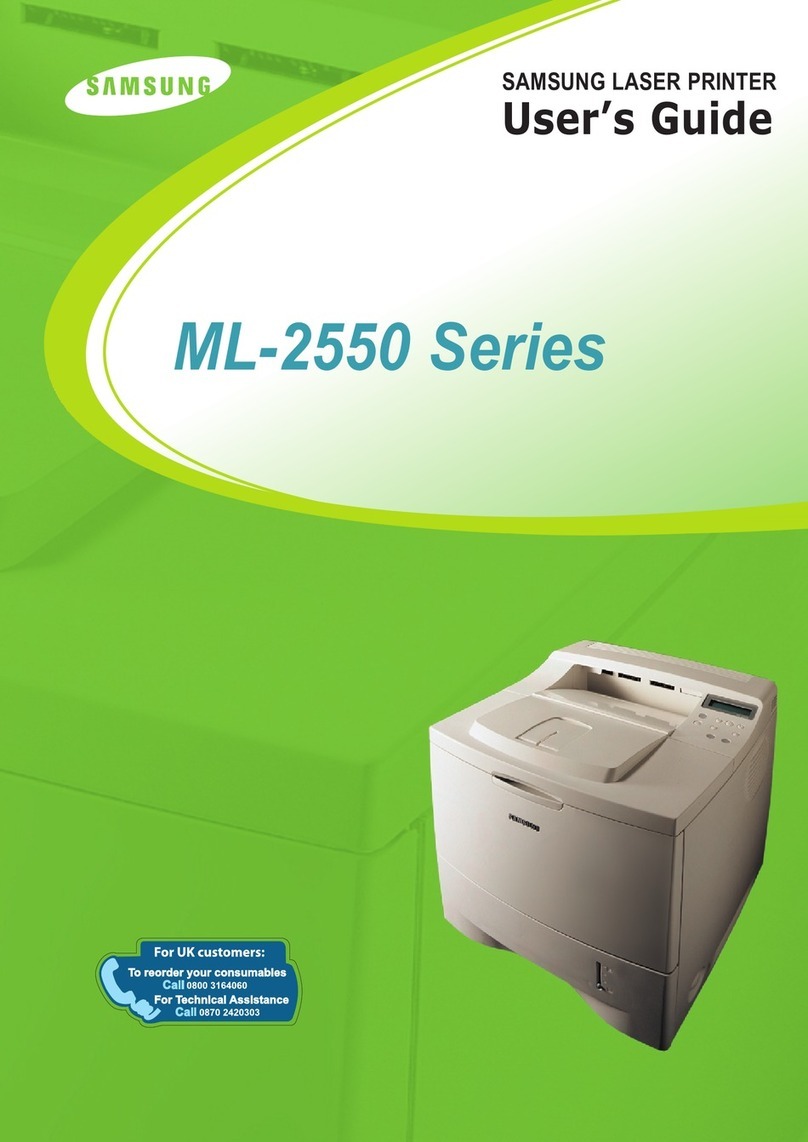iDiPOS TP-80 Troubleshooting guide

1. COMMANDS
1.1 Command Notation
[Name] The name of the command.
[Format] The code sequence.ASCII,Hex, Decimal 3 kinds of formats, default Decimal format.
[Range] Gives the allowable ranges for the arguments.
[Description] Describes the command’s function.
[Details] Describes the usage of the command in detail.
[Notes] Provides important information on setting and using the printer command,ifnecessary.
[Default] Gives the default values, if any, for the commandparameters.
[Reference] Lists related commands.
2. HT
[Name] Horizontal tab
[Format] ASCII HT
Hex 09
Decimal 9
[Description] Moves the print position to the next horizontal tab position.
[Details]
•
This command is ignored unless the next horizontal tab position hasbeen set.
•
If the next horizontal tab position exceeds the printing area, the printer sets the
printing position to [Printing area width + 1].
•
Horizontal tab positions are set with ESC D.
•
If this command is received when the printing position is at [printing area width
+ 1], the printer executes print buffer-full printing of the currentline and
horizontal tab processing from the beginning of the next line.
•
The default setting of the horizontal tab position for the paper roll is font A
(12
╳
24) every 8th character (9th, 17th, 25th, ... column).
[Reference] ESC D
3. LF
[Name] Print andline feed
[Format] ASCII LF
Hex 0A
Decimal 10
[Description] Prints the data in the print buffer and feeds oneline based on the currentline
spacing.
[Note] This command sets the print position to the beginning of the line.
[Reference] ESC 2, ESC 3
PROGRAM MANUAL
Thermal receipt printer TP-80

1
4. FF
[Name] Print and return to standard normal mode in page mode
[Format] ASCII FF
Hex 0C
Decimal 12
[Description] Prints the data in the print buffer collectively and returns to normal mode.
[Details] The buffer data is deleted after being printed.
The printing area set by ESC W is reset to the default setting.
The printer does not execute paper cutting.
This command sets the print position to the beginning of the line.
This command is enabled only in page mode.
[Reference] ESC FF,ESC L,ESC S
5. CAN
[Name] Cancel print data in page mode
[Format] ASCII CAN
Hex 18
Decimal 24
[Description] In page mode, deletes all the print data in the current printable area.
[Details] This command is enabled only in page mode.
If data that existed in the previously specified printing area also exists in the
currently specified printing area, it is deleted.
[Reference] ESC L,ESC W
6. DLE EOT n
[Name] Real-time status transmission
[Format] ASCII DLE EOT n
Hex 10 04 n
Decimal 16 4 n
[Range] 1 n4
[Description] Transmits the selected printer status specified by n in real-time, according to the
following parameters:
n = 1: Transmit printer status
n = 2: Transmit off-line status
n = 3: Transmit error status
n = 4: Transmit paper roll sensor status
[Details] The status is transmitted whenever the data sequence.
This command should not be used among the command that consists of 2 or
more bytes.
Even though the printer is not selected using ESC = (select peripheral device),
this command is effective.
The printer transmits the current status. Each status is represented by onebyte
data.

2
The printer transmits the status without confirming whether the host computer
can receive data.
The printer executes this command upon receiving it.
This command is ony available for serial port printer. The printer executes this
command upon receiving it any status.
n = 1: Printer status
Bit 0/1 Hex Decimal Function
0 0 00 0 Fixed to “0”.
1 1 02 2 Fixed to “1”.
2 0 00 0 One or two drawer open
1 04 4 Two drawers closed
3 0 00 0 On-line
1 08 8 Off-line
4 1 10 16 Fixed to “1”.
5,6 Undefined.
7 0 00 00 Fixed to “0”.
n = 2: Off-line status
Bit 0/1 Hex Decimal Function
0 0 00 0 Fixed to “0”
1 1 02 2 Fixed to “1”.
2 0 00 0 Cover is closed.
1 04 4 Cover is open.
3 0 00 0 Not press FEED button.
1 08 8 press FEED button
4 1 10 16 Fixed to “1”
5 0 00 0 No paper-end
1 20 32 Paper end
6 0 00 0 No error.
1 40 64 Error occurs.
7 0 00 0 Fixed to “0”
n = 3: Error status
Bit 0/1 Hex Decimal Function
0 0 00 0 Fixed to “0”
1 1 02 2 Fixed to “1”
2 - - - Undefined.
3 0 00 0 No auto-cutter error.
1 08 8 Auto-cutter error occurs.
4 1 10 16 Fixed to “1”
5 0 00 0 No unrecoverable error.
1 20 32 Unrecoverable error occurs.

3
6 0 00 0 Normal print head temperature and voltage
1 40 64 Abnormal print head temperature and voltage
7 0 00 0 Fixed to “0”
n = 4: Continuous paper sensor status
Bit 0/1 Hex Decimal Function
0 0 00 0 Fixed to “0”.
1 1 02 2 Fixed to “1”.
2,3 0 00 0 Paper enough
1 0C 12 Paper near-end
4 1 10 16 Fixed to “1”.
5,6 0 00 0 Paper enough
1 60 96 Paper end
7 0 00 0 Fixed to “0”.
[Reference] DLE ENQ, GS a, GS r
7. DLE ENQ n
[Name] Real-time request to printer
[Format] ASCII DLE ENQ n
Hex 10 05 n
Decimal 16 5 n
[Range] 1 n2
[Description] Responds to a request from the host computer. n specifies the requests as
follows:
n Request
1 Recover from an error and restart printing from the line where the error occurred
2 Recover from an error after clearing the receive and print buffers
[Details] This command is effective only when an auto-cutter error occurs.
The printer starts processing data upon receiving this command under serial port.
With a parallel interface model, this command can not be executed when the
printer is busy.
This command should not be contained within another command that consists
of two or more bytes.
When the printer is disabled with ESC = (Select peripheral device), the error
recovery functions (DLE ENQ 1 and DLE ENQ 2) are enabled, and the other
functions are disabled.
When the pulse is output to the connector pin specified while ESC p or DEL
DC4 is executed while this command is processed, this command is ignored.
The printer executes this command upon receiving it under serial port.
With a parallel interface model, this command cannot be executed when the
printer is busy.
If print data includes the same character strings as this command, the printer

4
performs the same operation specified by this command. The user must
consider above condition.
This command should not be used within the data sequence of another
command that consists of 2 or more bytes.
This command is effective even when the printer is disabled with ESC = (Select
peripheral device).
[Reference] ESC p
8. ESC FF (*)
[Name] Print data in page mode
[Format] ASCII ESC FF
Hex 1B 0C
Decimal 27 12
[Description] In page mode, prints all buffered data in the printing area collectively.
[Details] This command is enabled only in page mode.
After printing, the printer does not clear the buffered data, setting values for
ESC T and ESC W, and the position for buffering character data.
[Reference] FF,ESC L,ESC S
9. ESC SP n
[Name] Set right-side character spacing
[Format] ASCII ESC SP n
Hex 1B 20 n
Decimal 27 32 n
[Range] 0 ≤n≤255
[Description] Sets the character spacing for the right side of the character to [ n horizontal or
vertical motion units].
[Details] •When characters are enlarged n times, the right-side character spacing is n
times normal value.
•This command sets values independently in each mode (standard and page
modes).
•The horizontal and vertical motion unit are specified by GS P. Changing the
horizontal or vertical motion unit does not affect the current right-side spacing.
•The GS P command can change the horizontal (and vertical) motion unit.
However, the value cannot be less than the minimum horizontal movement
amount, and it must be in even units of the minimum horizontal movement
amount.
•In standard mode, the horizontal motion unit is used.
•In page mode, the horizontal or vertical motion unit differs in page mode,
depending on starting position of the printable area as follows:
1 When the starting position is set to the upper left or lower right of the
printable area using ESC T, the horizontal motion unit ( x) is used.
2 When the starting position is set to the upper right or lower left of the
printable area using ESC T, the vertical motion unit ( y) is used.
•The maximum right-side spacing is 31.91mm (255/203) inches. Any setting
exceeding the maximum is converted to the maximum automatically.
[Default] n= 0
[Reference] GS P
10. ESC ! n

5
[Name] Select print mode(s)
[Format] ASCII ESC ! n
Hex 1B 21 n
Decimal 27 33 n
[Range] 0 ≤n≤255
[Description] Selects print mode(s) using n as follows:
Bit 1/0 Hex Decimal Function
0 0 00 0 Character font A (12 ╳24).
1 01 1 Character font B (9 ╳17).
1 - - - Undefined.
2 - - - Undefined.
3 0 00 0 Emphasized mode not selected.
1 08 8 Emphasized mode selected.
4 0 00 0 Double-height mode not selected.
1 10 16 Double-height mode selected.
5 0 00 0 Double-width mode not selected.
1 20 32 Double-width mode selected.
6 - - - Undefined.
7 0 00 0 Underline mode not selected.
1 80 128 Underline mode selected.
[Details] •When both double-height and double-width modes are selected, quadruple size
characters are printed.
•The printer can underline all characters, but can not underline the space set by
HT or 90° clockwise rotated characters.
•The thickness of the underline is that selected by ESC , regardless of the
character size.
•When some characters in a line are double or more height, all the characters
on the line are aligned at the baseline.
•ESC E can also turn on or off emphasized mode. However, the setting of the
last received command is effective.
•ESC — can also turn on or off underline mode. However, the setting of the last
received command is effective.
•GS ! can also select character size. However, the setting of the last received
command is effective.
•Emphasized mode is effective for alphanumeric and Kanji. All print modes
except emphasized mode is effective only for alphanumeric.
[Default] n= 0
[Reference] ESC -,ESC E,GS !
11. ESC $ nL nH
[Name] Set absolute print position
[Format] ASCII ESC $ nL nH
Hex 1B 24 nL nH
Decimal 27 36 nL nH
[Range] 0 ≤nL ≤255
0≤nH ≤255
[Description] Sets the distance from the beginning of the line to the position at which

6
subsequent characters are to be printed.
•The distance from the beginning of the line to the print position is
[( nL + nH ╳256) ╳ (vertical or horizontal motion unit)] inches.
[Details] •Settings outside the specified printable area are ignored.
•The horizontal and vertical motion unit are specified by GS P.
•The GS P command can change the horizontal (and vertical) motion unit.
However, the value cannot be less than the minimum horizontal movement
amount, and it must be in even units of the minimum horizontal movement
amount.
•In standard mode, the horizontal motion unit ( x) is used.
•In page mode, horizontal or vertical motion unit differs depending on the
starting position of the printable area as follows:
1 When the starting position is set to the upper left or lower right of the
printable area using ESC T, the horizontal motion unit ( x) is used.
2 When the starting position is set to the upper right or lower left of the
printable area using ESC T, the vertical motion unit ( y) is used.
[Reference] ESC \,GS $,GS \,GS P
12. ESC % n
[Name] Select/cancel user-defined character set
[Format] ASCII ESC % n
Hex 1B 25 n
Decimal 27 37 n
[Range] 0 ≤nL ≤255
[Description] Selects or cancels the user-defined character set.
•When the LSB of nis 0, the user-defined character set is canceled.
•When the LSB of nis 1, the user-defined character set is selected.
[Details] •When the user-defined character set is canceled, the internal character set is
automatically selected.
•nis available only for the least significant bit.
[Default] n= 0
[Reference] ESC &,ESC ?
13. ESC & y c1 c2 [x1 d1...d(y
╳
x1)]...[xk d1...d(y
╳
xk)]
[Name] Define user-defined characters
[Format] ASCII ESC & y c1 c2 [
╳
1 d1...d(y
╳
x1)]...[xk d1...d(y
╳
xk)]
Hex 1B 26 y c1 c2 [
╳
1 d1...d(y ╳x1)]...[xk d1...d(y
╳
xk)]
Decimal 27 38 y c1 c2 [
╳
1 d1...d(y
╳
x1)]...[xk d1...d(y
╳
xk)]
[Range] y= 3
32 ≤c1 ≤c2 ≤126
0≤x≤12 Font A (12 ╳24)
0≤x≤9 Font B (9 ╳17)
0≤d1 ... d(y
╳
xk) ≤255
[Description] Defines user-defined characters.
•yspecifies the number of bytes in the vertical direction.
•c1 specifies the beginning character code for the definition, and c2 specifies the
final code.
•xspecifies the number of dots in the horizontal direction.
[Details] •The allowable character code range is from ASCII code <20>H to <7E>H (95
characters).
•It is possible to define multiple characters for consecutive character codes.
If only one character is desired, use c1 = c2.
•dis the dot data for the characters. The dot pattern is in the horizontal direction

7
from the left side. Any remaining dots on the right side are blank.
•The data to define a user-defined character is (y ╳x) bytes.
•Set a corresponding bit to 1 to print a dot or 0 to not print a dot.
•This command can define different user-defined character patterns by each
fonts. To select a font, use ESC !
•A user-defined character and a downloaded bit image cannot be defined
simultaneously. When this command is executed, the downloaded bit image is
cleared.
•The user-defined character definition is cleared when:
①ESC @ is executed.
②ESC ? is executed.
③FS q is executed.
④GS *is executed.
⑤The printer is reset or the power is turned off.
•When the user-defined characters are defined in font B (9 ╳17), only the most
significant bit of the 3rd byte of data in vertical direction is effective.
[Default] The internal character set
[Reference] ESC %,ESC ?
[Example]
•When font A (12 ╳24) is selected.
•When font B (9 ╳17) is selected.

8
14. ESC *m nL nH d1... dk
[Name] Select bit-image mode
[Format] ASCII ESC *m nL nH d1...dk
Hex 1B 2A m nL nH d1...dk
Decimal 27 42 m nL nH d1...dk
[Range] m= 0, 1, 32, 33
0≤nL ≤255
0≤nH ≤3

9
0≤d≤255
[Description] Selects a bit-image mode using m for the number of dots specified by nL and nH,
as follows:
mMode
Vertical Direction Horizontal Direction
Number of
Dots
Dot
Density
Dot
Density
Number of Data
(K)
0 8-dot single-density 8 67 DPI 100 DPI nL + nH
╳
256
1 8-dot double-density 8 67 DP 200 DPI nL + nH
╳
256
32 24-dot single-density 24 200DPI 100 DPI (nL + nH
╳
256)
╳
3
33 24-dot double-density 24 200 DPI 200DPI (nL + nH
╳
256)
╳
3
[dpi:dot/25.4mm{1”}]
[Details] •If the values of mis out of the specified range, nL and data following are
processed as normal data.
•The nL and nH indicate the number of dots of the bit image in the horizontal
direction. The number of dots is calculated by nL + nH
╳
256.
•If the bit-image data input exceeds the number of dots to be printed on a line,
the excess data is ignored.
•dindicates the bit-image data. Set a corresponding bit to 1 to print a dot or to 0
to not print a dot.
•If the width of the printing area set by GS L and GS W less than the width
required by the data sent with the ESC *command, the following will be
performed on the line in question (but the printing cannot exceed the maximum
printable area):
①The width of the printing area is extended to the right to accommodate the
amount of data.
②If step ①does not provide sufficient width for the data, the left margin is
reduced to accommodate the data.
•After printing a bit image, the printer returns to normal data processing mode.
•This command is not affected by print modes (emphasized, double-strike,
underline, character size or white/black reverse printing), except upside-down
printing mode.
•The relationship between the image data and the dots to be printed is as
follows:
•When 8-dot bit image is selected:

10
•When 24-dot bit image is selected
15. ESC – n
[Name] Turn underline mode on/off
[Format] ASCII ESC - n
Hex 1B 2D n
Decimal 27 45 n
[Range] 0 ≤n≤2, 48 ≤n≤50
[Description] Turns underline mode on or off, based on the following values of n:
nFunction
0, 48 Turns off underline mode
1, 49 Turns on underline mode (1-dot thick)
2, 50 Turns on underline mode (2-dots thick)
[Details] •The printer can underline all characters (including right-side character spacing),
but cannot underline the space set by HT.
•The printer cannot underline 90 clockwise rotated characters and white/black
inverted characters.
•When underline mode id turned off by setting the value of n to 0 or 48, the
following data is not underlined, and the underline thickness set before the
mode is turned off does not change. The default underline thickness is 1 dot.
•Changing the character size does not affect the current underline thickness.
•Underline mode can also be turned on or off by using ESC !. Note, however,
that the last received command is effective.
•This command does not affect the setting of Kanji characters.
[Default] n= 0
[Reference] ESC !
16. ESC 2
[Name] Select default line spacing

11
[Format] ASCII ESC 2
Hex 1B 32
Decimal 27 50
[Description] Selects 3.75mm line spacing.
[Details] •The line spacing can be set independently in standard mode and in page mode.
[Reference] ESC 3
17. ESC 3 n
[Name] Set line spacing
[Format] ASCII ESC 3 n
Hex 1B 33 n
Decimal 27 51 n
[Range] 0 ≤n≤255
[Description] Sets the line spacing to [ n
╳
vertical or horizontal motion unit] inches.
[Details] •The line spacing can be set independently in standard mode and in page mode.
•The horizontal and vertical motion unit are specified by GS P. Changing the
horizontal or vertical motion unit does not affect the current line spacing.
•The GS P command can change the horizontal (and vertical) motion unit.
However, the value cannot be less than the minimum vertical movement
amount, and it must be in even units of the minimum vertical movement
amount.
•In standard mode, the vertical motion unit (y) is used.
•In page mode, this command functions as follows, depending on the starting
position of the printable area:
①When the starting position is set to the upper left or lower right of the
printable area using ESC T, the vertical motion unit (y) is used.
②When the starting position is set to the upper right or lower left of the print
able area using ESC T, the horizontal motion unit ( x) is used.
• The maximum paper feed amount is 956mm . Even if a paper feed amount of
more than 956mm is set, the printer feeds the
paper only 956mm.
[Default] Line spacing equivalent to approximately 3.75mm.
[Reference] ESC 2,GS P
18. ESC = n
[Name] Choose printer
[Format] ASCII ESC = n
Hex 1B 3D n
Decimal 27 61 n
[Range] 0 ≤n ≤ 1
[Description] Selects device to which host computer sends data, using nas follows:
Bit 1/0
Hex Decimal Function
00 00 0 Printer disabled
1 01 1 Printer enabled
1-7 - - - Undefined
[Details] When the printer is disabled, it ignores all data except for error-recovery commands
(DLE EOT, DLE ENQ, DLE DC4).

12
[Default] n= 1
19. ESC ? n
[Name] Cancel user-defined characters
[Format] ASCII ESC ? n
Hex 1B 3F n
Decimal 27 63 n
[Range] 32 ≤n≤127
[Description] Cancels user-defined characters.
[Details] •This command cancels the pattern defined for the character code specified by
n. After the user-defined characters is canceled, the corresponding pattern for
the internal character is printed.
•If a user-defined character has not been defined for the specified character
code, the printer ignores this command.
[Reference] ESC &,ESC %
20. ESC @
[Name] Initialize printer
[Format] ASCII ESC @
Hex 1B 40
Decimal 27 64
[Description] Clears the data in the print buffer and resets the printer mode to the mode that
was in effect when power on.
[Details] •The DIP switch settings are not checked again.
•The data in the receive buffer is not cleared.
•The macro definition is not cleared.
•The NV bit image data is not cleared.
•The data of the user NV memory is not cleared.
21. ESC D n1...nk NUL
[Name] Set horizontal tab positions
[Format] ASCII ESC D n1...nk NUL
Hex 1B 44 n1...nk 00
Decimal 27 68 n1...nk 0
[Range] 1 ≤n≤255
0≤k≤32
[Description] Sets horizontal tab positions.
•nspecifies the column number for setting a horizontal tab position from the
beginning of the line.
•kindicates the total number of horizontal tab positions to be set.
[Details] •The horizontal tab position is stored as a value of [character width
╳
n]
measured from the beginning of the line. The character width includes the
right-side character spacing, and double-width characters are set with
twice the width of normal characters.

13
•This command cancels the previous horizontal tab settings.
•When setting n= 8, the print position is moved to column 9 by sending HT.
•Up to 32 tab positions ( k= 32) can be set. Data exceeding 32 tab positions is
processed as normal data.
•Transmit [ n] k in ascending order and place a NUL code 0 at the end.
•When [ n] k is less than or equal to the preceding value [ n] k-1, tab setting is
finished and the following data is processed as normal data.
•ESC D NUL cancels all horizontal tab positions.
•The previously specified horizontal tab positions do not change, even if the
character width changes.
•The character width is memorized for each standard and page mode.
[Default] The default tab positions are at intervals of 8 characters (columns 9, 17, 25,...) for
font A (12 ╳ 24).
[Reference] HT
22. ESC E n
[Name] Turn emphasized mode on/off
[Format] ASCII ESC E n
Hex 1B 45 n
Decimal 27 69 n
[Range] 0 n 255
[Description] Turns emphasized mode on or off
• When the LSB of n is 0, emphasized mode is turned off.
• When the LSB of n is 1, emphasized mode is turned on.
[Details] • Only the least significant bit of n is enabled.
• This command and ESC ! turn on and off emphasized mode in the same way.
Be careful when this command is used with ESC !.
[Default] n = 0
[Reference] ESC !
23. ESC G n
[Name] Turn on/off double-strike mode
[Format] ASCII ESC G n
Hex 1B 47 n
Decimal 27 71 n
[Range] 0 ≤n≤255
[Description] Turns double-strike mode on or off.
•When the LSB of nis 0, double-strike mode is turned off.
•When the LSB of nis 1, double-strike mode is turned on.
[Details] •Only the lowest bit of nis enabled.
•Printer output is the same in double-strike mode and in emphasized mode.
[Default] n= 0
[Reference] ESC E
24. ESC J n

14
[Name] Print and feed paper
[Format] ASCII ESC J n
Hex 1B 4A n
Decimal 27 74 n
[Range] 0 ≤n≤255
[Description] Prints the data in the print buffer and feeds the paper [ n
╳
vertical or horizontal
motion unit] inches.
[Details] •After printing is completed, this command sets the print starting position to the
beginning of the line.
•The paper feed amount set by this command does not affect the values set by
ESC 2 or ESC 3.
•The horizontal and vertical motion unit are specified by GS P.
•The GS P command can change the vertical (and horizontal) motion unit.
However, the value cannot be less than the minimum vertical movement
amount, and it must be in even units of the minimum vertical movement
amount.
•In standard mode, the printer uses the vertical motion unit ( y).
•In page mode, this command functions as follows, depending on the starting
position of the printable area:
①When the starting position is set to the upper left or lower right of the
printable area using ESC T, the vertical motion unit (y) is used.
②When the starting position is set to the upper right or lower left of the print
able area using ESC T, the horizontal motion unit ( x) is used.
•The maximum line spacing is 956mm. When the setting value exceeds the
maximum, it is converted to the maximum automatically.
[Reference] GS P
25. ESC L
[Name] Select page mode
[Format] ASCII ESC L
Hex 1B 4C
Decimal 27 76
[Description] Switches from normal mode to page mode.
[Details] •This command is enabled only when processed at the beginning of a line in
standard mode.
•This command has no effect in page mode.
•After printing by FF is completed or by using ESC S, the printer returns to
standard mode.
• This command sets the position where data is buffered to the position specified
by ESC T within the printing area defined by ESC W.
•This command switches the settings for the following commands (in which the
values can be set independently in standard mode and page mode) to those for
page mode:
①Set right-side character spacing: ESC SP, FS S
②Select default line spacing: ESC 2, ESC 3
•Only valve settings is possible for the following commands in page mode; these
commands are not executed.
① Turn 90°clockwise rotation mode on/off: ESC V
② Select justification: ESC a

15
③ Turn upside-down printing mode on/off: ESC {
④ Set left margin: GS L
⑤ Set printable area width: GS W
•The following command is ignored in page mode:
① Execute test print: GS ( A
•The following command is not available in page mode:
① Print NV bit image: FS p
②Define NV bit image: FS q
③Write to user NV memory: FS g 1
④ Print raster bit image: GS v 0
•The printer returns to standard mode when power is turned on, the printer is
reset, or ESC @ is used.
[Reference] FF,CAN,ESC FF,ESC S,ESC T,ESC W,GS $,GS \
26. ESC M n (*)
[Name] Select character font
[Format] ASCII ESC M n
Hex 1B 4D n
Decimal 27 77 n
[Range] n = 0, 1, 48, 49
[Description] Selects character fonts.
n
Function
0,48 Character font A (12 24) selected.
1,49 Character font B (9 17) selected.
27. ESC R n
[Name] Select an international character set
[Format] ASCII ESC R n
Hex 1B 52 n
Decimal 27 82 n
[Range] 0 ≤n≤15
[Description] Selects an international character set nfrom the following table:
nCharacter
0 U.S.A.
1 France
2 Germany
3 U.K.

16
4 Denmark I
5 Sweden
6 Italy
7 Spain I
8 Japan
9 Norway
10 Denmark II
11 Spain II
12 Latin
13 Korea
14 Slovenia/Croatia
15 Chinese
[Default] n = 0
28. ESC S (*)
[Name] Select standard mode
[Format] ASCII ESC S
Hex 1B 53
Decimal 27 83
[Description] Switches from page mode to standard mode.
[Details] This command is effective only in page mode.
Data buffered in page mode are cleared.
This command sets the print position to the beginning of the line.
The printing area set by ESC W are initialized.
This command switches the settings for the following commands (in which the
values can be set independently in standard mode and page mode) to those for
standard mode:
①Set right-side character spacing: ESC SP, FS S
②Select default line spacing: ESC 2, ESC 3
The following commands are enabled only to set in standard mode.
①Set printing area in page mode: ESC W
②Select print direction in page mode: ESC T
The following commands are ignored in standard mode.
①Set absolute vertical print position in page mode: GS $
②Set relative vertical print position in page mode: GS \
Standard mode is selected automatically when power is turned on, the printer is
reset, or command ESC @ is used.
[Reference] FF,ESC FF,ESC L
29. ESC T n (*)
[Name] Select print direction in page mode
[Format] ASCII ESC T n
Hex 1B 54 n
Decimal 27 84 n

17
[Range] 0 n3
48 n51
[Description] Selects the print direction and starting position in page mode.
n specifies the print direction and starting position as follows:
n Print Direction Starting Position
0, 48 Left to right Upper left
1, 49 Bottom to top Lower left
2, 50 Right to left Lower right
3, 51 Top to bottom Upper right
[Details] When the command is input in standard mode, the printer executes only
internal flag operation. This command does not affect printing in standard
mode.
This command sets the position where data is buffered within the printing area
set by ESC W.
Parameters for horizontal or vertical motion units ( x or y) differ as follows,
depending on the starting position of the printing area:
①If the starting position is the upper left or lower right of the printing area, data
is buffered in the direction perpendicular to the paper feed direction:
Commands using horizontal motion units: ESC SP,ESC $,ESC \
Commands using vertical motion units: ESC 3,ESC J,GS $,GS \
②If the starting position is the upper right or lower left of the printing area, data
is buffered in the paper feed direction:
Commands using horizontal motion units: ESC 3,ESC J,GS $,GS \
Commands using vertical motion units: ESC SP,ESC $,ESC \
[Default] n = 0
[Reference] ESC $,ESC L,ESC W,ESC \,GS $,GS P,GS \
30. ESC V n
[Name] Turn 90clockwise rotation mode on/off
[Format] ASCII ESC V n
Hex 1B 56 n
Decimal 27 86 n

18
[Range] 0 n1, 48 n49
[Description] Turns 90clockwise rotation mode on/off
n is used as follows:
n Function
0, 48 Turns off 90clockwise rotation mode
1, 49 Turns on 90clockwise rotation mode
[Details] This command affects printing in standard mode. However, the setting is
always effective.
When underline mode is turned on, the printer does not underline 90
clockwise-rotated.
Double-width and double-height commands in 90rotation mode enlarge
characters in the opposite directions from double-height and double- width
commands in normal mode.
[Default] n = 0
[Reference] ESC !, ESC
31. ESC W xLxHyLyHdxLdxHdyLdyH(*)
[Name] Set printing area in page mode
[Format] ASC II ESC W xL xH yL yH dxL dxH dyL dyH
Hex 1B 57 xL xH yL yH dxL dxH dyL dyH
Decimal 27 87 xL xH yL yH dxL dxH dyL dyH
[Range] 0 xL, xH, yL, yH, dxL, dxH, dyL, dyH 255 (except dxL= dxH=0 or dyL= dyH=0)
[Description] The horizontal starting position, vertical starting position, printing area width,
and printing area height are defined as x0, y0, dx (inch), dy (inch), respectively.
Each setting for the printing area is calculated as follows:
x0 = [( xL + xH 256) (horizontal motion unit)]
y0 = [( yL + yH 256) (vertical motion unit)]
dx = [ dxL + dxH 256] (horizontal motion unit)]
dy = [ dyL + dyH 256] (vertical motion unit)]
The printing area is set as shown in the figure below.
[Details] If this command is input in standard mode, the printer executes only internal
flag operation. This command does not affect printing in standard mode.
If the horizontal or vertical starting position is set outside the printable area, the
printer stops command processing and processes the following data as normal
data.
If the printing area width or height is set to 0, the printer stops command
processing and processes the following data as normal data.
This command sets the position where data is buffered to the position specified
by ESC T within the printing area.
If (horizontal starting position + printing area width) exceeds the printable area,
the printing area width is automatically set to (horizontal printable area -
horizontal starting position).
If (vertical starting position + printing area height) exceeds the printable area,
the printing area height is automatically set to (vertical printable area - vertical
starting position).

19
The horizontal and vertical motion unit are specified by GS P. Changing the
horizontal or vertical motion unit does not affect the current printing area.
The GS P command can change the horizontal (and vertical) motion unit.
However, the value cannot be less than the minimum horizontal movement
amount, and it must be in even units of minimum horizontal movement amount.
Use the horizontal motion unit ( x) for setting the horizontal starting position and
printing area width, and use the vertical motion unit ( y) for setting the vertical
starting position and printing area height.
When the horizontal starting position , vertical starting position, printing area
width, and printing area height are defined as X, Y, Dx, and Dy respectively, the
printing area is set as shown in the figure below.
This printable area for this printer is approximately 73 mm in the horizontal
direction and approximately 150mm in the vertical direction.
[Default] xL = xH = yL = yH = 0
dxL = 72, dxH = 2, dyL = 176, dyH = 4
[Reference] CAN,ESC L,ESC T,GS P
32. ESC \ nL nH
[Name] Set relative print position
[Format] ASCII ESC \ nL nH
Hex 1B 5C nL nH
Decimal 27 92 nL nH
[Range] 0 ≤nL ≤255
0≤nH ≤255
[Description] Sets the print starting position based on the current position by using the
horizontal or vertical motion unit.
•This command sets the distance from the current position to [( nL + nH
╳
256) ╳
horizontal or vertical motion unit]
[Details] •Any setting that exceeds the printable area is ignored.
•When pitch N is specified to the right:
nL+ nH
╳
256 = N
Table of contents
Other iDiPOS Printer manuals

